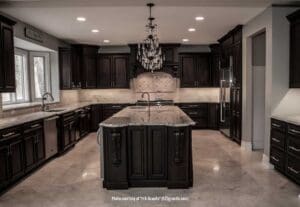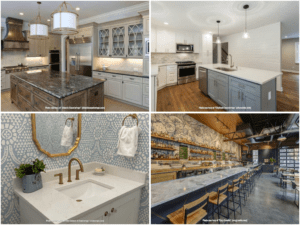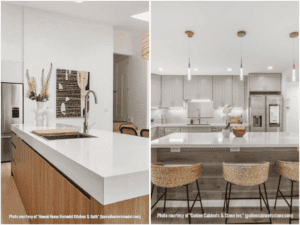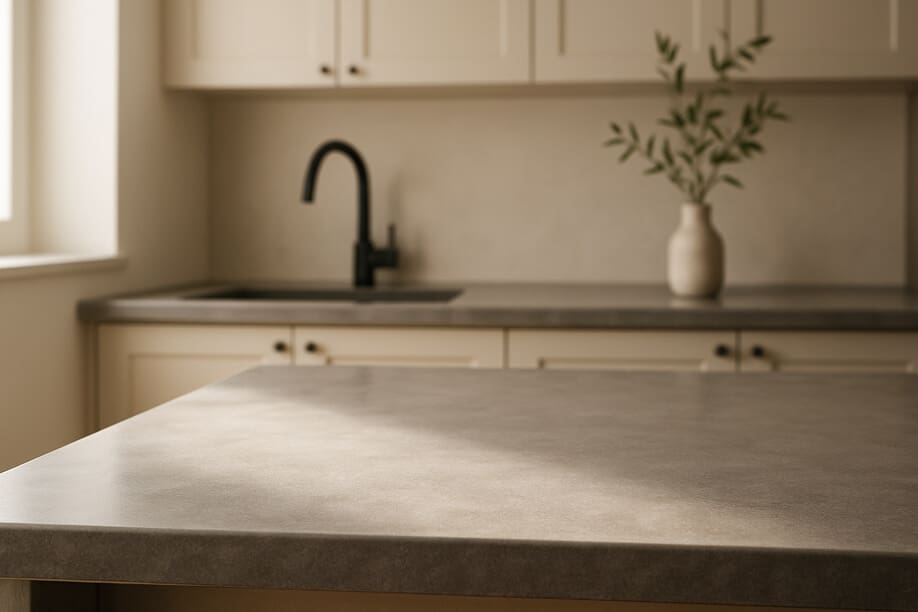
Introduction
Polished cement countertops are becoming an increasingly popular feature in modern kitchens and bathrooms. They fit beautifully into industrial, minimalist, and farmhouse interiors, offer rich texture, and allow plenty of room for individuality. On top of that, more and more people are starting to wonder: is it possible to make this kind of surface yourself?
If you’re reading this article, you’ve probably already asked yourself that question— and that's a great first step. I know firsthand how important it is to understand the details before buying materials or hiring a contractor. There’s a lot that’s not obvious about concrete countertops: sure, they look great, but they require a specific approach. Without the right knowledge, it’s easy to make mistakes — and end up spending more time, money, and nerves than you expected.
In this article, I’ll explain what polished cement countertops and polished concrete counters actually are, what the difference is between concrete and cement, how to pour in place concrete countertops, and how to achieve that signature shiny concrete countertop look. You’ll learn how much they cost, what to prepare for if you go the DIY route, and get an honest look at the pros and cons, plus how these countertops work with different interiors. Ready? Let’s get into it!
What Is a Polished Cement Countertop?
If you’ve never heard this term before, let’s clear things up right away: polished concrete counters and polished cement countertops aren’t exactly the same thing, even though people often use them interchangeably. In practice, most countertops aren’t made from pure cement, but from concrete — a mix of cement, sand, gravel, and additives that, once poured and polished, becomes a strong and striking surface.
Why is this distinction important? Because the composition directly affects the weight of the structure, its strength, drying behavior, and how well it polishes. Whether you plan to DIY or hire a contractor, knowing the right terminology helps you communicate your needs clearly and avoid misunderstandings.
There are three main types of these countertops on the market:
- Precast countertops — concrete is poured into molds off-site, then the countertop is delivered and installed in place.
- Poured in place (how to make concrete countertops in place) — concrete is formed directly on top of the kitchen cabinets. This requires careful preparation but ensures a perfect fit.
- Smaller molds — for windowsills, vanities, or island countertops. These are lighter, easier to install, and often done as DIY projects.
What should you choose?
It depends on your situation: if you're in the middle of a full renovation, pour-in-place makes sense — especially for non-standard kitchen layouts. But if your kitchen is already installed, it’s safer to go with precast options so you don’t risk damaging your cabinets.
Pros and Cons of Polished Cement Countertops
Like any material, polished concrete counters have their strengths and weaknesses. And while they may look stunning on Pinterest, in reality, much depends on the quality of workmanship, proper sealing, and how you use them.
What do people love about them?
- Uniqueness. Concrete surfaces are one-of-a-kind — no two patterns, shades, or textures are exactly alike.
- DIY-friendly. If you’re thinking of making your own countertop, this is one of the few durable materials accessible for DIY.
- Style versatility. Loft, Scandinavian, modern farmhouse — concrete fits wherever texture and natural finishes matter.
- Strength and durability. With proper finishing, these countertops can last for decades.
And what are the challenges?
- Weight. These countertops can weigh over 200 pounds — they need a reinforced base.
- Porosity. Without sealant, concrete absorbs water, grease, and acids — leading to stains and dullness.
- Maintenance. To keep that shiny concrete countertop look, you’ll need to reseal and wax it regularly.
- Complex fabrication. Not everyone is up for the mixing, reinforcing, curing, grinding, and polishing stages.
Real-world feedback:
I’ve heard all kinds of opinions — from thrilled to disappointed. So instead of guessing, I checked what people who’ve actually gone through the process are saying. Here are a few examples I found on Reddit:
“I made a bathroom countertop, but skipped the sealing step - after a month it had toothpaste and soap marks. The second one has already been treated with epoxy resin and now everything is fine.” — u/DaveSmith85 (Reddit)
“I opted for polished cement countertops because I wanted something unconventional but understated. It took a little bit of maintenance, but the result was worth it.” — @Mary_lgd (Reditt)
How to Make the Right Choice?
If you’re ready to maintain the surface and want a truly original interior feature, concrete could be a great choice. But if low-maintenance matters most, quartz or ceramic might be better. It all depends on how you use your kitchen — as a showpiece or a real workspace.
How Much Does a Cement Countertop Cost?
The cost of polished cement countertops can vary widely depending on design complexity, polish level, installation type, and location.
Option 1: Buying a Ready-Made Countertop
If you’re hiring professionals to fabricate and install polished concrete counters, expect the following costs:
- $50–$150 per square foot — depending on the design complexity, polish level, and extra features
- Installation — $30–$90 per hour, depending on your region and the contractor’s experience
- Total cost for an average kitchen (30–40 sq. ft.) — $1,500–$6,000
These prices are comparable to other materials like granite or quartz, but concrete gives you more flexibility in design and individuality.
Option 2: DIY Countertop
If you decide to create concrete countertops yourself, here’s what you’re looking at:
Materials:
- Concrete mix, pigments, reinforcing mesh — $5–$15 per sq. ft.
- Molds and framing — $2–$4 per sq. ft.
- Sealers and finishing products — $1–$3 per sq. ft.
Tools:
- Concrete mixer, grinder, vibration platform — $50–$150 to buy; renting is usually cheaper
Time:
- Around 20–40 hours for the full cycle — from mold prep to final finish
In total:
- $6–$15 per sq. ft., depending on your materials and tools
- The savings are significant — especially if you already own some tools
Which is More Cost-Effective?
If you’re new to working with concrete, it might be worth hiring professionals to avoid costly mistakes. But if you have the experience and motivation, a DIY project can be both budget-friendly and deeply rewarding.
How to Make a Concrete Countertop Yourself
In short — the process takes patience, but it’s totally doable. To create concrete countertops (how to create concrete countertops), here’s what you’ll need to do:
- Build a mold — use MDF (Medium Density Fiberboard) or plywood with sealed edges.
- Mix the concrete — it should be thick, not runny, and include reinforcing additives.
- Pour the mix into the mold (how to make concrete countertops in place) — use vibration to remove air bubbles.
- Let it cure for 3–5 days — don’t remove the form earlier.
- Grind and seal — this determines the shine, durability, and hygiene.
I built a concrete countertop for a laundry room a few years ago and learned that the devil’s in the details. That’s why I wouldn’t recommend stopping at this brief overview.
It covers literally EVERYTHING: from pros and cons to step-by-step pouring, curing, grinding, care, and real-life examples from Instagram, Reddit, Pinterest, and Home Depot. It’s more than just inspiration — it’s a full-on practical manual. If you’re serious about a DIY project, start there. It will save you time, energy, and help you avoid common mistakes.
How Do Polished Cement Countertops Look in Interior Design?
I’m not a designer, but over the years I’ve seen plenty of kitchens and bathrooms — both great and questionable ones. And I can say for sure: polished concrete counters aren’t limited to harsh industrial styles. When integrated properly, they can look truly impressive.
Where I most often see concrete — and it looks good:
Kitchens with open shelving and natural cabinetry — concrete adds the perfect amount of “texture.”
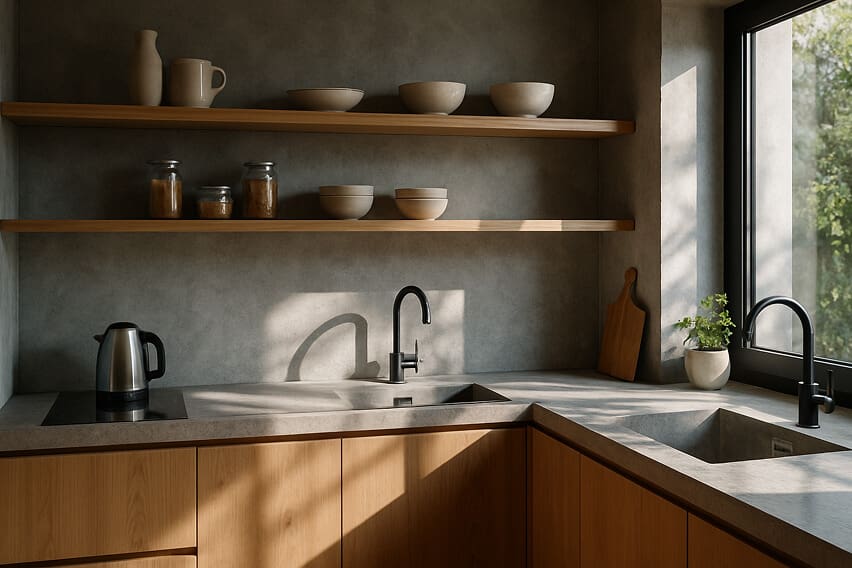
Light Scandinavian interiors — it pairs beautifully with white cabinetry, creating a clean and refined look.
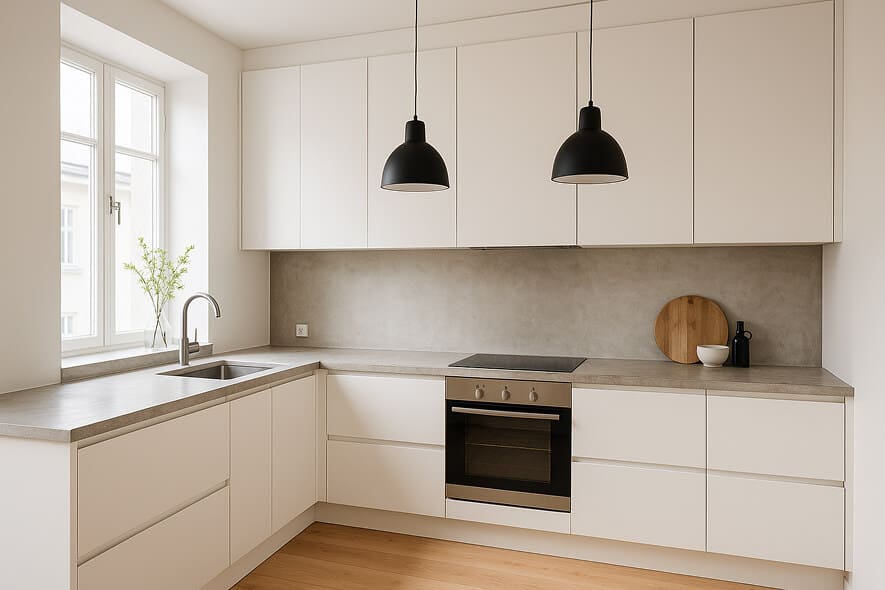
Farmhouse or rustic kitchens — especially when combined with wood and warm accents.

Loft-style apartments — when you want something raw, but still stylish.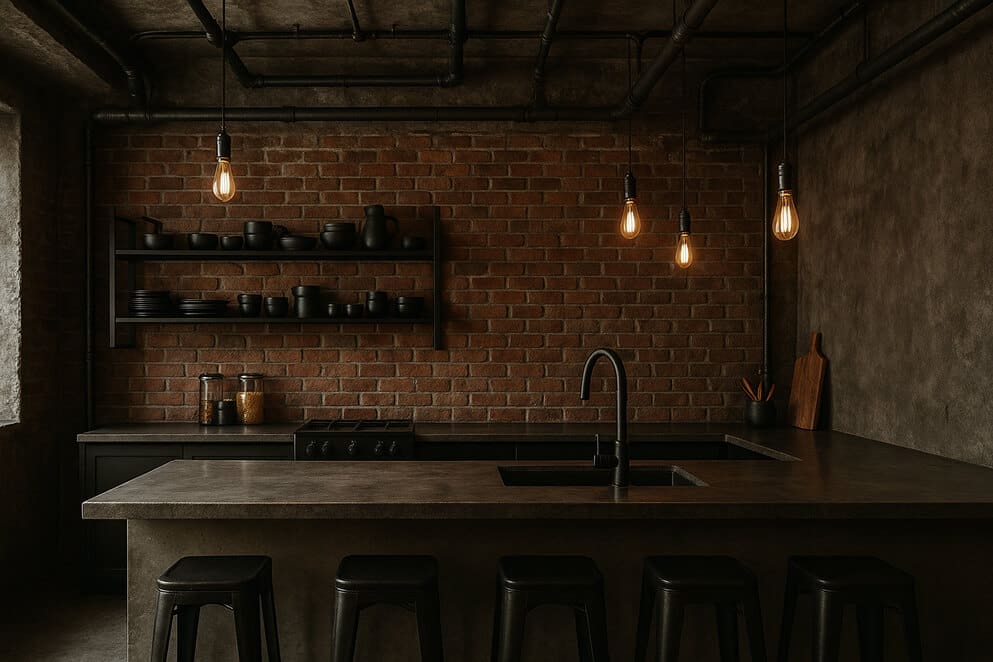
Best Material Combinations for Your Kitchen
Concrete + wood — always a winning combo. Even with simple cabinets, a concrete countertop gives the space character.
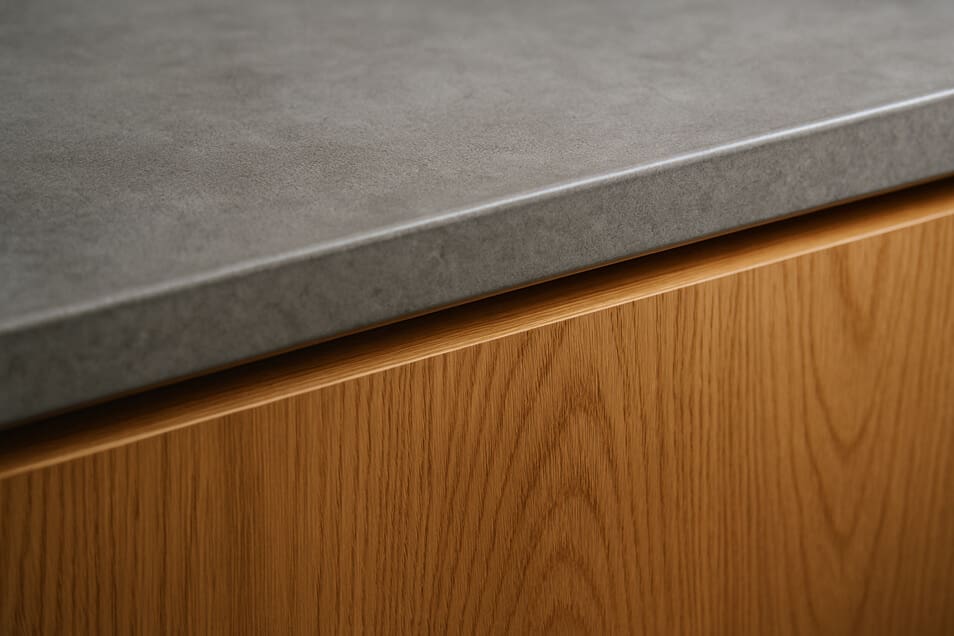
Concrete + light tones — white or cream cabinetry highlights the texture of concrete beautifully.

Concrete + black hardware — bold but modern.

Concrete + brass or copper — especially in the details: handles, light fixtures, faucets.

Sometimes, a shiny concrete countertop with a semi-matte finish can even look cooler than quartz. The key is not to go overboard with the shine — too much can make the surface appear slippery.
How to Care for a Cement Countertop
Polished cement countertops and shiny concrete countertops look impressive — but only if they’re properly maintained. Concrete is a porous material, and without protection, it quickly absorbs whatever lands on it.
Honestly, caring for a concrete countertop isn’t something anyone wants to do — but it’s absolutely necessary. The moment you stop resealing it on time, stains will start to appear — from oil, coffee, and even plain water.
What Can You Do to Make It Last?
- Wipe the surface dry after cleaning — avoid water streaks.
- Don’t place hot pots or pans directly on the surface — always use trivets.
- Wipe up spilled wine, coffee, or juice immediately — especially acidic substances.
- Use neutral cleaning products — no acids or bleach.
- Don’t cut directly on the surface — concrete is tough, but chips easily.
Sealing: When and Why?
Every concrete surface needs sealing. Just because it looks good doesn’t mean it’s protected.
- Initial sealing — right after grinding and drying
- Re-sealing — every 12–24 months, depending on usage
- Absorption test — drip a little water on the surface. If it soaks in or leaves a mark, it’s time to reseal.
I usually recommend applying wax to the countertop every six months. It takes about 15 minutes, but it helps keep the shine longer and prevents dullness.
What If There Are Already Stains?
- Minor stains — gently sand with fine-grit sandpaper
- Deep stains — try a mild bleach-and-water solution (1:5), then rinse immediately
- Cracks — fill with a repair compound, sand smooth, and reseal
Taking care of a concrete countertop isn’t hard — as long as you understand why you’re doing it. You don’t need perfection, just consistency: reseal on time, wax periodically, and wipe the surface after cooking. These little habits will ensure your polished concrete counter stays beautiful for years to come. Concrete is a material with character — and if you treat it right, it’ll reward you with both looks and longevity.
FAQ: Frequently Asked Questions
How much does a shiny concrete countertop cost, and can I make one myself?
Yes, you can. It all depends on whether you're ready to invest time and get some hands-on practice. A DIY project usually costs around $600–$1,000*, depending on the tools and finishing products. A ready-made shiny concrete countertop from a contractor might cost $1,500 to $3,000* for a mid-sized kitchen.
What’s the difference between a polished concrete counter and a polished cement countertop?
Typically, "cement" refers to one ingredient in the mix, while "concrete" is the final building material. So, technically, polished concrete counter is more accurate. But in everyday use — especially in DIY circles or when working with contractors — both terms are used interchangeably.
How do I make a cement countertop in place (how to make a cement countertop in place) without cracks?
There are three key factors: proper mix proportions, reinforcement, and even curing. Don’t rush it — allow at least three days for drying before grinding. And don’t skip the sealing step after the surface has dried.
How do I care for polished cement countertops so they stay shiny and don’t absorb stains?
Routinely reseal them (every 12–24 months), avoid letting acidic liquids (like wine, juice, vinegar) sit on the surface, and apply a soft wax every six months. It only takes a few minutes but extends the countertop’s life by years.
Is a concrete countertop a good match for a kitchen with white cabinets?
Absolutely. The contrast between gray or charcoal concrete and white cabinetry looks fresh and modern. Add black hardware or wood accents, and you’ll have a balanced, stylish kitchen without making it look too stark.
Conclusion
Polished cement countertops aren’t just a trend. They’re a way to bring texture, character, and a sense of craftsmanship into your home. But behind those sleek Pinterest-worthy surfaces lies a series of real decisions — materials, pouring method, maintenance, sealing.
If you’ve read this far, you now have a complete picture of what this material is, how it works, and what it takes to make sure your concrete doesn’t disappoint — but delights.
Do you need a countertop like this? The answer depends, as always, on your goals, taste, and willingness to commit to some upkeep. But if you’re ready to go for it, the next step is deciding — will you make it yourself, or hire a pro?
If you’re leaning toward hiring professionals, skip the endless searching — check out The First National Ranking of Stone Countertop Fabricators and Installers in the U.S. It features vetted companies from across the country who truly know how to work with stone and concrete. Choose reliable contractors — and bet on a great result.
Thanks for sticking with me. Wishing you the best of luck with your future countertop — and may it serve you well, just like concrete is built to do.
Also read:
- Do Granite Countertops Need Sealing? Busting Myths and Providing a Clear Answer
- Do specialty products protect marble and granite countertops from dirt or not?
* The price is valid as of May, 2025, published for informational purposes and may differ on the day the article is read. Prices are based on average data from Home Depot, Houzz, HomeAdvisor, and other relevant sources in the U.S.
All images are sourced from Unsplash and Pinterest photo stock or publicly available contractor portfolios. If you believe any image is privately owned and used without proper credit, please contact us at contact@countertopcontractors.com.
Some authors may write under a pseudonym and choose not to disclose their identities for personal reasons. We respect their privacy and simply provide a platform for professional, educational use. We are not responsible for name coincidences with real individuals. All contributors are vetted for expertise, but we advocate for freedom of expression.














